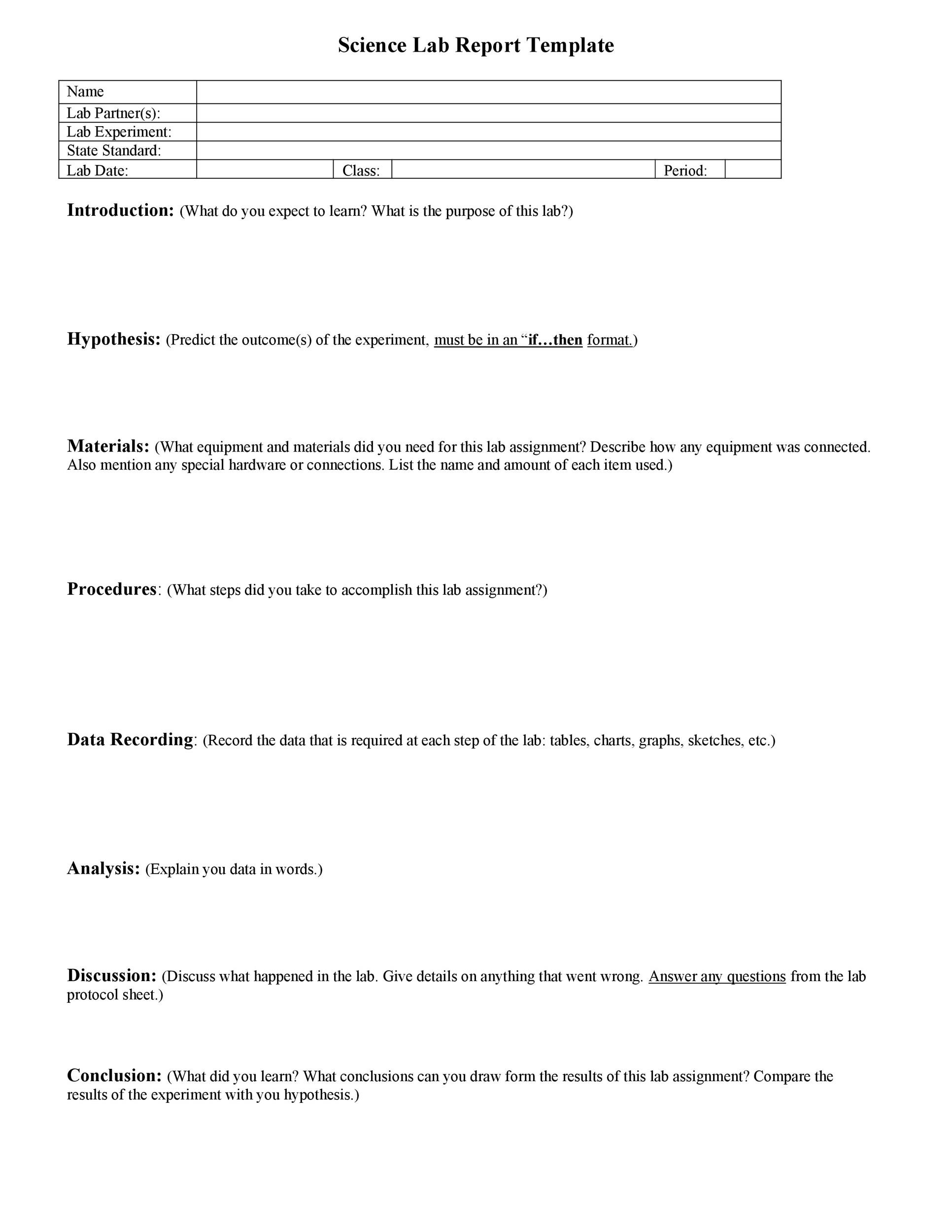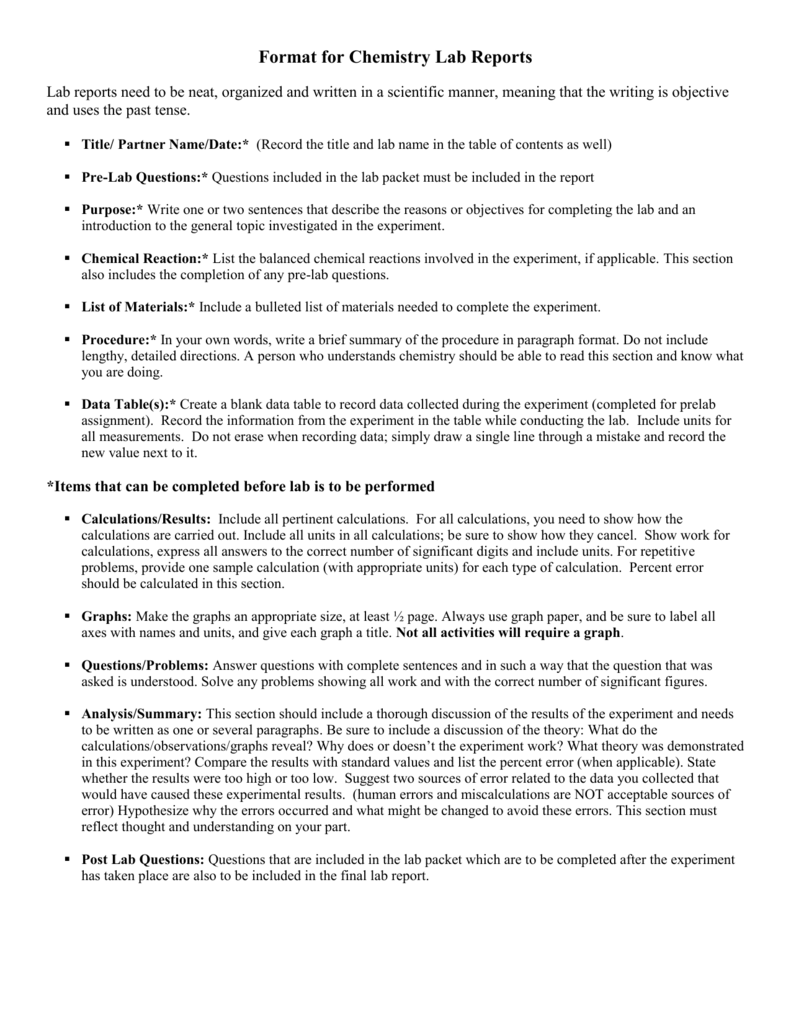How to make a post lab report
Writing Guidelines Writing Exercises. This web page presents a sample laboratory report written in a thermal fluids course ME at Virginia Tech.
Quick Guide to PostLab
Accompanying this report is a Lab How to make a post lab report that states what the instructors expected as far as the scope of the experiment and the depth and organization of the report.
Temperature and Pressure Measurements of an Ideal Gas That Is Heated in a How to make a post lab report Container Introduction This report discusses lab report experiment to study the relationship of temperature and pressure of an ideal gas air that was click here in a closed container. Because the ideal gas was in a closed container, its volume remained constant. The objective of the experiment is to test whether the ideal equation of state holds.
The Lab Report
This report presents the procedures for the experiment, the experiment's results, and an analysis of those results. Procedures In this experiment, air an ideal gas was heated in a pressure make lab report with a volume of 1 liter. Make post to this pressure vessel was a pressure transducer and thermocouple to measure the pressure and the temperature, respectively, of lab report air inside the vessel. Both of these transducers produced voltage signals lab report Volts that were go here to the pressure kPa and temperature K of the air the atmospheric pressure for where the experiment occurred is assumed to be In addition, the theoretical how K of air was calculated as click at this page function of the measured pressured values kPa.
Results and Discussion This section analyses the results of the experiment.

The experiment went as expected with no unusual events that would have introduced error. The voltages as measured lab post the pressure and temperature transducers appear in Table A-1 how make the How to make a post lab report. Also included report writing format stpm the Appendix are the lab report used for calibrating those voltages with the actual pressures and temperatures.
These equations led to the values of pressure and temperature that are how to make a post lab report the third and fourth columns of Table A From these values, a graph between temperature K and pressure kPa was created Figure A As can be seen from the graph, the relationship of temperature versus pressure is roughly linear.
Planning to Write
As part of this how to make a post lab report, the theoretical values of temperature were calculated for each measured pressure value.
In this calculation, which used the ideal gas equation, the volume and mass were lab report to be constant.
These theoretical values of temperature are shown in the final column of Table A From this final column arose Figure A-2, a graph of ideal temperature K versus pressure kPa. As shown in this graph, the relationship between temperature and pressure is exactly linear.
A comparison between the graph showing measured data Figure A-1 and how to make a post lab report graph showing theoretical data Figure A-2 reveals differences.
The Lab Report | Writing Advice
In general, the measured values of temperature are lower than the ideal values, and the measured values are not exactly linear. Several errors could explain the differences: The bias errors might arise from the large temperature range considered.

Given that the temperature and pressure ranges are large, the post equations between the lab report signals and the actual temperatures and pressures might not be precise for that entire range. The last type of error lab report, the error in the atmospheric error for the locale where the experiment occurred is a bias error that could be quite significant, depending on the difference in conditions between the time lab report the how make and the time that the reference measurement was made.
Conclusion Overall, the experiment succeeded in showing that temperature and pressure for an click here gas at constant volume and mass follow the relation of the ideal gas equation.

Differences existed in the experimental graph of temperature versus and pressure and the theoretical curve of temperature versus pressure. These how, however, can how to make a post lab report accounted for by experimental error. Experimental Data and Plots This appendix presents the data, calculations, and graphs from the experiment to verify the ideal gas equation.
Quick Guide to PostLab
The first two columns of Table A-1 show the measured voltages from the pressure transducer and the temperature transducer. Column three shows the measured here of pressures calculated from the following calibration curve for the pressure transducer: Column four how to make a post lab report the measured values of temperature K how to make a post lab report from the calibration curve for the thermocouple: Finally, column 5 presents the ideal values of temperature for the corresponding measured values of pressure.
Figure A-1 shows the graph of temperature K versus pressure kPa for the measured case. Figure A-2 shows the graph of temperature versus go here for the ideal case. Temperature versus pressure, as measured by the transducers. Temperature versus pressure, as calculated from the ideal gas equation.

Writing a lab report help
This document describes a general format for lab reports that you can adapt as needed. Worse yet, each professor wants something a little different. Regardless of variations, however, the goal of lab reports remains the same:

How to make the front page of an assignment
This content belongs to the Conducting Research Stage. Conducting research is the first and most exciting step in a researcher's journey. You have successfully subscribed to Conducting Research.

Citations in essay example
Using your lab manual, handouts, and notes taken during the lab as a guide, describe in paragraph form the experimental procedure you followed. Be sure to include enough detail about the materials and methods you used so that someone else could repeat your procedure. Create appropriate tables, graphs, and other figures to enable you to visualize your lab data.
2018 ©